Farm Musings ARCHIVE . 2021
The Dearth
July 25, 2021
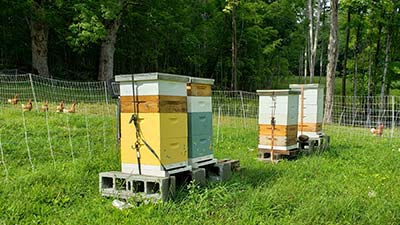 It's high summer, a time of warmth, luxurious green everywhere and seeming abundance. In the bee world, it is the start of the summer nectar dearth. After the explosion of flowers in spring and before the fall flowers like goldenrod and asters arrive, there is a period of time when nectar and pollen are difficult to find. Bees have to wander further and further for less available food and have to rely on their spring stores to get them through. It is often when a hive will fail due to lack of food, hive robbing from other stronger hives or mite infestation that weakens their defenses. Add in a human “robber” harvesting honey and it is a stressful time to be a bee.
It's high summer, a time of warmth, luxurious green everywhere and seeming abundance. In the bee world, it is the start of the summer nectar dearth. After the explosion of flowers in spring and before the fall flowers like goldenrod and asters arrive, there is a period of time when nectar and pollen are difficult to find. Bees have to wander further and further for less available food and have to rely on their spring stores to get them through. It is often when a hive will fail due to lack of food, hive robbing from other stronger hives or mite infestation that weakens their defenses. Add in a human “robber” harvesting honey and it is a stressful time to be a bee.
I feel like this time of year is my own personal dearth. The flush of spring greens grown in a newly refreshed spring garden with a winter refreshed farmer has passed. The heat has taken a toll on heat-sensitive greens like lettuce and some brassicas. This year's excessive rain has flushed the soil of vital nutrients to keep things growing well and has set up some crops for rot and mildew issues. The long hours working seven days a week have taken their toll on me too. The greens are tired, the soil is tired, the farmer is tired.
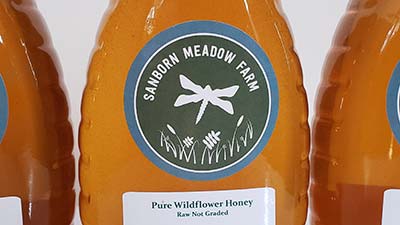 To help the honeybees, my husband fed them well in early spring and just finished the first treatment for mites. When we harvest honey shortly (YAY!), he will not take all of their honey but will leave them with enough to get through the coming weeks. We watch vigilantly for hive robbing and other signs of distress. We also leave large sections of our property unmown so that the goldenrod and native asters will provide pollen and nectar close to home in a few weeks. And, once the fall flowers have passed, Scott will start feeding the bees to build up their food stores and do the final mite treatment to give them the best chance of making it through the coming winter.
To help the honeybees, my husband fed them well in early spring and just finished the first treatment for mites. When we harvest honey shortly (YAY!), he will not take all of their honey but will leave them with enough to get through the coming weeks. We watch vigilantly for hive robbing and other signs of distress. We also leave large sections of our property unmown so that the goldenrod and native asters will provide pollen and nectar close to home in a few weeks. And, once the fall flowers have passed, Scott will start feeding the bees to build up their food stores and do the final mite treatment to give them the best chance of making it through the coming winter.
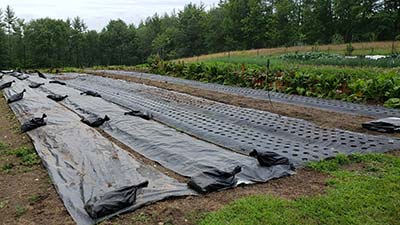 In the garden, I am in the process of resetting the lettuce beds. A fresh layer of compost and organic fertilizer and a couple of weeks under a tarp will refresh the soil and suppress weeds. I've been seeding plug trays with new lettuces and will transplant the first wave of young seedlings this week. I keep sowing and planting various bunched brassica greens (tatsoi, Koji, pac choi, etc.) in the hopes that the heat or flea beetles will abate enough to allow hole-free unbolted growth. I did have to spray Pyganic to control the flea beetles and will likely have to again. They are relentless. The Swiss chard bed got a good cleaning to remove weeds and all the dead and diseased foliage that could ruin the rest of the crop. It will get a dose of fertilizer and a top dressing of compost to get it through until fall. Plans are already formulating in my head for how to make certain crops easier to maintain next year, including growing chard and kale using paper mulch.
In the garden, I am in the process of resetting the lettuce beds. A fresh layer of compost and organic fertilizer and a couple of weeks under a tarp will refresh the soil and suppress weeds. I've been seeding plug trays with new lettuces and will transplant the first wave of young seedlings this week. I keep sowing and planting various bunched brassica greens (tatsoi, Koji, pac choi, etc.) in the hopes that the heat or flea beetles will abate enough to allow hole-free unbolted growth. I did have to spray Pyganic to control the flea beetles and will likely have to again. They are relentless. The Swiss chard bed got a good cleaning to remove weeds and all the dead and diseased foliage that could ruin the rest of the crop. It will get a dose of fertilizer and a top dressing of compost to get it through until fall. Plans are already formulating in my head for how to make certain crops easier to maintain next year, including growing chard and kale using paper mulch.
Soon I will start seeding spinach into plug trays to plant out in mid-August for a fall harvest. New kale seedlings are ready to go into a newly refreshed bed to grow into fall's kale bonanza. The main crop and storage carrots have been planted and are already a few inches tall. The “early” carrot crop is just now starting to size up. It's WAY behind where it should be – I should have harvested most of it by now – but I guess it's just another example of a strange growing year.
As for the farmer, well, that's a work in progress. I'm exhausted. The house renovation is substantially finished but my part of the work still hangs over my head. It's been too hot, for me, or too wet to paint the exterior sections that need finishing before winter. The cabinet doors still reside in the barn waiting for cleaning, sanding, priming and painting. I did finish painting all of the cabinet drawers which allowed us to fully move into our renovated kitchen.
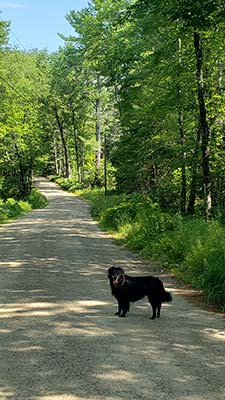 Slowly, I've been ticking off trim caulking and painting sections with a late September furniture delivery as a deadline.
My perennial garden behind the house is looking lovely despite my having gone into it to do maintenance exactly once since May. I've been monitoring it from the kitchen window, running out to pluck weeds that pop up above the foliage. Mostly, I've been in the market garden, planting, weeding, harvesting. It's tough to get away from it this time of year. I can't even imagine how I would have handled meat chickens or turkeys this year and I'm glad we decided to not do them.
Slowly, I've been ticking off trim caulking and painting sections with a late September furniture delivery as a deadline.
My perennial garden behind the house is looking lovely despite my having gone into it to do maintenance exactly once since May. I've been monitoring it from the kitchen window, running out to pluck weeds that pop up above the foliage. Mostly, I've been in the market garden, planting, weeding, harvesting. It's tough to get away from it this time of year. I can't even imagine how I would have handled meat chickens or turkeys this year and I'm glad we decided to not do them.
Thinking about the dearth has shifted my perspective a bit. This is the time of year when it is difficult to take care of myself in the maelstrom of summer farm activities. I know my usual expectations of perfection are the reason I tend to push through at all costs. I am learning, though slowly, that the garden will still be there if I take a day off and that if there's no lettuce for the market this week, people will understand. I took a long overdue walk with my dog two days ago. Tomorrow, I am hiking out of state with a friend. Yesterday Scott and I worked hard all day so today, I'm resisting the urge to plant in the rain and I'm writing this blog instead. A few breaks here and there will help restore the energy I'll need to get through to fall's cooler weather and the abundance of the fall harvests for the market.
The dearth is temporary and with the right efforts I, like the bees, can make it through to a less stressful time of year. And, the good news is: it's almost honey time! Look for announcements of availability on our social media pages soon!
Seasons and Other Changes
April 1, 2021
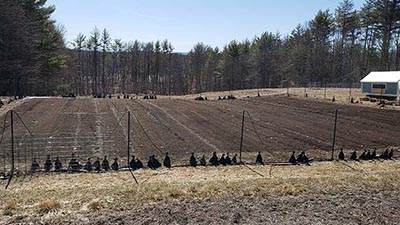 Sometime in February, I noticed the light had changed. The sun rose higher in the sky and the light had changed to a warmer tone. It is an energizing change that every year has me looking forward to the warmer weather to come. In the fall, I always take note of the day I realize the light has changed to a cooler, bluer tone and, usually, it's with a sigh of relief that the busy season is nearing an end. But now, in March, after a few months of sleep and rest and a couple of winter house projects completed, the warming and lengthening light is just what I need to refocus on getting ready for the market season. This season's change brings not only the start of the growing season but the beginning of another major project on the farm.
Sometime in February, I noticed the light had changed. The sun rose higher in the sky and the light had changed to a warmer tone. It is an energizing change that every year has me looking forward to the warmer weather to come. In the fall, I always take note of the day I realize the light has changed to a cooler, bluer tone and, usually, it's with a sigh of relief that the busy season is nearing an end. But now, in March, after a few months of sleep and rest and a couple of winter house projects completed, the warming and lengthening light is just what I need to refocus on getting ready for the market season. This season's change brings not only the start of the growing season but the beginning of another major project on the farm.
As I write this at the dining room table, the rest of the main living areas look strangely empty. The couch, the old table island in the kitchen, the dining table sit alone without the usual evidence of a well-lived home. The books and cookware and wall art have been tucked away upstairs, awaiting their return once the chaos that is set to begin on Friday settles down. We are beginning a major remodeling project, dubbed "Phase 2" that includes the kitchen, dining and living rooms. "Phase 1" in this old house was completed at the end of 2015 before we officially moved in. Thankfully, we did not have to live in the house through the majority of Phase 1. We rented an apartment nearby as we searched for a farm to buy and there were a few months left in the lease when Phase 1 started. This time, we will be relegated to living in our master suite and the upstairs, trying to manage daily cooking without a kitchen and keeping the kittens from getting sheet rocked inside the walls. Although we hired a contractor, I will be doing all of the painting – walls, ceilings, trim, cabinetry – to save money, plus staying on top of all the little decisions that need to be made as the project moves along. It's an exciting project we've been planning since we finished with Phase 1 in 2016 so the inconvenience of the next few months is a worthy price to pay for finally completing this phase in our farm house restoration project.
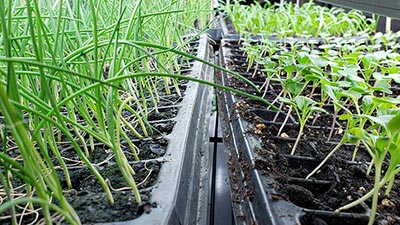
Of course, time spent painting and looking at sink fixtures means time NOT spent out in the market garden getting vegetables to grow. In the spirit of trying to keep myself sane and not over-committed as is my tendency, I have to cut back a bit this season to compensate. This means no farm shares, likely no poultry for sale, and a slimming down of the list of vegetables grown. I will be at the Canterbury Community Farmers Market starting in June and will still sell products at the Canterbury Country Store, as well as at Gilmanton's Own starting in April.
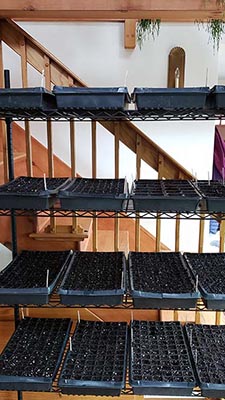 The focus this year will be on greens and roots – the usual assortment of greens I've always grown, hopefully with more volume, plus carrots, beets, radishes, scallions, spring onions. Snap peas are still on the list too. Gone from the garden are tomatoes (gasp!), summer squash, green beans (mostly), cucumbers and storage onions. We will grow a small amount of green beans for our own consumption and any extra will appear at the market. Tomatoes and green beans take up so much time, either with maintenance and pruning (tomatoes) or picking (beans) that they were the first to go. Squash and cukes have always been a struggle for me with the ongoing cucumber beetle and squash bug battles.
Plus, let's be honest, no one wants another zucchini in July and my field cukes can't compete with greenhouse grown in quality and volume. Storage onions take up too much valuable space for almost the entire season and don't generate enough revenue from my small garden to justify continuing to grow them for market. The rows freed up by the dismissal of those vegetables can be used to grow more greens, more carrots and beets. Who knows, this may turn out to be my new direction with the garden, depending on how the season goes. Always changing...
The focus this year will be on greens and roots – the usual assortment of greens I've always grown, hopefully with more volume, plus carrots, beets, radishes, scallions, spring onions. Snap peas are still on the list too. Gone from the garden are tomatoes (gasp!), summer squash, green beans (mostly), cucumbers and storage onions. We will grow a small amount of green beans for our own consumption and any extra will appear at the market. Tomatoes and green beans take up so much time, either with maintenance and pruning (tomatoes) or picking (beans) that they were the first to go. Squash and cukes have always been a struggle for me with the ongoing cucumber beetle and squash bug battles.
Plus, let's be honest, no one wants another zucchini in July and my field cukes can't compete with greenhouse grown in quality and volume. Storage onions take up too much valuable space for almost the entire season and don't generate enough revenue from my small garden to justify continuing to grow them for market. The rows freed up by the dismissal of those vegetables can be used to grow more greens, more carrots and beets. Who knows, this may turn out to be my new direction with the garden, depending on how the season goes. Always changing...
I look out from my dining table spot out into The Addition (our pet name for the mud room/laundry/ storage/market fridges/pass through "wing") where shelves with grow lights are crammed full of plug trays. The coming cold weather over the next few days means the two overflow shelving units will be crammed with trays from the lean-to deck greenhouse that need to be kept warm at night until spring returns next week. The growing season is upon us, even if the weather isn't quite ready to let go of the winter season just yet.
An Opportunity
February 3, 2021
A friend of mine shared an article this past spring that struck a chord. I sat on it, and this blog entry, for the rest of 2020, not quite ready to share my thoughts with the rest of you.
Here's the article, have a read: Prepare for the Ultimate Gaslighting* You are not crazy, my friends. By: Julio Vincent Gambuto. Apr 10, 2020
Then, read the follow-up article: The Gaslighting of America Has Begun - Understand your power, my friends. Business and government do. By: Julio Vincent Gambuto, May 1, 2020
As we emerge from the COVID-19 crisis, we will be at a crossroads as a country and a society. Among all of the complex issues we will face as a nation - the economy, healthcare, politics, our country's preparedness for the next pandemic, etc. – there is one closer to home that we actually have direct control over every day: our own lives and how we choose to live them. When you are forced to pause, exist without the constant buzz of daily demands, what is really important becomes more readily apparent. It is a profound and meaningful moment that we should not allow to pass by.
I had my own profound and meaningful moment of sorts in January 2008. I hesitate to this day to share even parts of this story because my September 2007 bicycle accident and the months that followed still haunt me despite my "get on with it" exterior persona. On that day in January 2008, I sat on the couch in our living room in upstate NY, having just spent Christmas week in the hospital, exhausted, silently suffering from trauma flashbacks, a bag of Vancomycin hooked up to a picc line in my upper arm, wet-to-dry bandages packed into an open, infected abscess on my collarbone – the result of an orthopedic surgery gone awry. It was a very dark and scary moment in my life.
Prior to this, I'd been doing what many of us do, going through life as we believe we're supposed to. Working. Doing. Consuming. Constantly moving, definitely not stopping to smell the roses. As an example of how programmed to always be "working" I was, as I was lying on the gurney in the ER after my accident some 3 months earlier, my first request to my future husband was to call my coworker to tell her I wasn't coming into work the next day. (Sorry Tracey. I was an idiot.) Turns out, I wouldn't return to work for nearly 4 weeks, during which time I got married, then out again for surgery, then back to work for nearly 2 months while an infection silently festered in my collarbone. I had to be at work! And I couldn't understand why my body wasn't cooperating. It wasn't until I came close to developing sepsis and my white-as-a-sheet orthopedic surgeon walked into my hospital room with an infectious disease doctor in tow that I realized I might need to adjust my expectations.
Back to the couch on that January day…though I didn't realize it as fully then as I would later, that low point was the catalyst that started me on the path to becoming the farmer, homesteader, and real food advocate that I am today. It was a wandering journey, with lots of questions and doubt, but one thing was always clear. Doing what I'd always done - returning to the "normal" life of working, doing, consuming, sitting in traffic, constantly moving on auto-pilot without considering if what I was working for, doing, or consuming was of real value to me – wasn't going to cut it anymore. "Life is short" took on a whole new meaning.
In 2015, 7 years after that moment on the couch, with lots of "behind the scenes" work, we bought our farm here in NH, I quit my job and started on my journey to bring real meaning to what I do every day. Tending to the earth. Growing nutritious food for us and our neighbors. Working to change the food system one customer at a time. Getting involved in our community. Sitting under the maple tree with a cold root beer on a hot summer day. So much of what I used to do has been happily cast aside and, although I physically work longer and harder for a lot less money than I ever have, it is a busy life of my choosing. What I have allowed to remain in my life has real meaning and purpose to me.
So, what does my story have to do with today's world and farming? This is a farm blog after all, right? During this current crisis, many people's lives suddenly stopped, without the traumatic accident scenario, I hope. Gone for many is the day to day auto-pilot existence of working, doing, buying, shuttling from one activity to the next, etc. Soon enough, "normal" life will start up again and we have an opportunity to think about what we let back into our lives or what we now consider to be our "normal" lives.
One of the reasons growing and eating real food as well as supporting a resilient food system is so important to me is because food is as basic a necessity as there is. We are what we eat, what we eat eats, and how what we eat is grown, treated, processed, cooked, etc. Food MATTERS, not just as nutrition and sustenance, but in the many ways food connects us to each other. I've watched as the weaknesses of our current food system have finally come out into the light for all to see. There is a price to pay for cheap food, not just in our health and the environment, but in how we value food and its ability to connect us to our families and neighbors. What if we choose to continue to buy meat, eggs and produce from the farmers in our area that we ran to in the panic over empty store shelves because it's better for us and helps keep our money in our community? Maybe we skip the corporate fast food and cook a meal with our family from ingredients sourced entirely from local farms. Start a garden or raise a few chickens and view the effort not as "work" but as a learning experience with the bonus of good food as a reward. Perhaps work to develop your own local food network made up of your neighbors and neighboring farms. Make a weekly trip to the farmers market a family affair, along with planning a menu of meals to be made using products purchased at the market. Seek out a local food co-op. Use each choice to build upon the next one as you consider what matters to you. Use this moment to reset your "normal" way of buying, preparing and eating food. And, please, do not fall for the fallacy that local food is "too expensive". Trust me, you are paying the same for cheap food, the difference in price made up in medical bills, environmental degradation, loss of rural communities, and your tax dollars used for corporate agriculture subsidies.
Of course, this is an opportunity to evaluate more than just our food choices but other areas of our lives. I'll leave it to each reader to decide what that entails for them. It is worth considering a reboot to a life more purposefully lived, with less of the "stuff" we don't really need and more of the good things we all should have: friends, community, access to good food, a government for all, things that "spark joy" (to quote Marie Kondo). We won't be able to change our "normal" lives overnight. It took me 13 years to get to this point on my journey and not everyone can leave a career to start a farm. Start small, one step at a time. Don't miss this chance.
Goodbye 2020
January 21, 2021
Well, that was quite a year. And 2021, as of this writing, is shaping up to be another humdinger.
As the growing season ended and I took stock of the year gone by, I realized I hadn't written anything for most of it. Although I struggle to write when the season is in full swing anyway, this year had the added impediment of not knowing how to put together the words to describe my thoughts on what was happening. As I've said before, I don't consider myself to be a particularly eloquent writer. My fingers on the keyboard are often overwhelmed by the ruminations in my head, so my default is to process in silence. Closing down the farm for the winter – cleaning up the gardens, stacking firewood, putting away tools – offers a lot of time to ponder and make sense of things without the worry of getting ready for market each week. I thought I would focus this blog entry on my impressions of the past growing and market season. Future entries may wander a bit in and out of a focus on the farm...we'll see how that brain-to-keyboard connection goes.
In my last blog, back in March, I wrote about changes we were making to meet the challenges of the developing pandemic. I believe most of us thought it was to be a short-lived exercise, that we would get a handle on things relatively quickly and life would soon return to "normal". Obviously, that didn't happen. I was fortunate in that I normally spend most of my time working on the farm, so the changing levels of "stay at home" requirements had little effect on my day-to-day living. I was able to focus on the farm and stay away from most of the pandemic induced panic and hype in the outside world, indulging my hermit tendencies. My husband, with his off-farm job, was not so lucky. I was able to get a number of home and farm projects ticked off the to-do list as well as get the market garden and the first rounds of seedlings ready for warmer weather.
In the lead up to the opening day of the Canterbury Community Farmers Market in June, the market board met regularly to discuss how and if we were going to be able to open. Unbelievably, many farmers markets were closed around the country, despite grocery stores – in enclosed buildings with questionable ventilation capabilities – being allowed to remain open. We decided, with the support of the town, we would open as planned, with a few changes to how things were set up and run. I was really proud of the market board. The many hours of work put in by the board and our volunteer squad over several months made it possible for our community to enjoy the market this summer. It was "community" at its finest.
I added a farm share program with pre-ordering and delivery to my already overloaded season plan in order to make sure my customers were able to get what they needed if they weren't able to visit the market. It was well received and a lot of fun to do. It did eat up a lot of time so I will have to consider carefully whether or not to do it again in future years. As always, I struggle with giving myself too much to do!
When the market opened in June, the support from the community was amazing. Many customers visited my booth and thanked me for being there and I know other vendors received the same sentiments. Only a handful of people objected to the mask requirement or the one-way flow of traffic through the market space. A few of my regular customers did not come to the market for health reasons, but overall, it felt like a "normal" market season. Just with masks. And no hugging. However, I'm convinced people enjoyed the market more, appreciated being out and seeing friends. I certainly did. I believe many of the vendors also felt we were stepping outside ourselves to help our community in this small way.
The rest of the season flew by in a blur, as it usually does. We brought back laying hens to the farm with the purchase of 17-week-old pullets in May that were laying by June. We raised two batches of meat chickens and a small flock of turkeys as well. Lots of poultry in various pastures on the farm made for a very busy summer. Though Scott and I had processed a few chickens and turkeys in the past, this was the first year we processed all of the meat birds ourselves, with some additional labor supplied by a few friends. As head of the "evisceration team", I made it through both batches of meat chickens and 10 of the 11 turkeys before I cut a finger with my knife. A darn good record for our first year of processing! The market garden was very productive and we sold more produce than ever at the market, at the Country Store and in our farm share program. Even with the drought this summer, my irrigation system was able to keep plants growing. We are thankful for our deep well! My husband's bees survived the drought but it was a difficult year for them. We took less honey than we hoped to harvest in order to give them more to get through this winter. We did lose one hive but, considering we started in spring with 2 hives, expanded to 6 and were left with 5 strong hives by fall, we're pleased with how they did.
There were many things about this past year that were surprising. I was particularly amazed by the response of farms in communities all around, changing how they operated, coming together to make sure good food was available for people who needed it. I was surprised by the colossal failure of our country's food system to respond to the pandemic as it unfolded. It became abundantly clear that our highly efficient, just-in-time delivery, cost reductionist, consolidated, monopolized food system had zero room to handle upsets. The small, local farmers were able to pivot quickly to meet the needs of their customers while supermarket shelves were bare and people were panicking over shortages. Our culture of cheap food left us vulnerable to supply disruptions while farmers were forced to throw away good food because they couldn't sell or process it. For every consumer, this should have been appalling and a wake up call. There needs to be strong action now to change food accessibility everywhere, starting with breaking up the meat processing monopolies and expanding the number of small and medium local processing facilities throughout the country.
For me, the main takeaway from this past year, once I filtered out all the negativity thrown at us on a daily basis, was that the pandemic brought out the best in a lot of people. It seemed to stop people in their tracks, make them look around, and focus on what was important. Community, helping our neighbors, kindness. Just within my tiny town of Canterbury, I saw a tremendous upswell of people helping each other, checking on their neighbors, offering their time, labor, whatever they could. I'm hopeful that enough of this goodness remains after this crisis is over to perhaps reset our focus on what's really important. For now, my attention turns to the seed catalogues and 2021 garden plan, inventorying my seed starting supplies, taking hikes with my dog and working on my aching back. Moving forward to brighter days ahead.